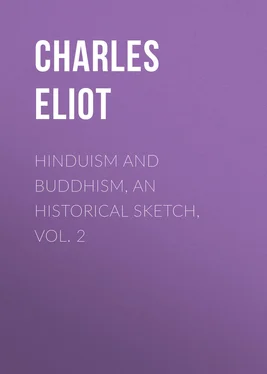Charles Eliot - Hinduism and Buddhism, An Historical Sketch, Vol. 2
Здесь есть возможность читать онлайн «Charles Eliot - Hinduism and Buddhism, An Historical Sketch, Vol. 2» — ознакомительный отрывок электронной книги совершенно бесплатно, а после прочтения отрывка купить полную версию. В некоторых случаях можно слушать аудио, скачать через торрент в формате fb2 и присутствует краткое содержание. Жанр: foreign_religion, Философия, Религиозная литература, foreign_psychology, foreign_antique, foreign_prose, на английском языке. Описание произведения, (предисловие) а так же отзывы посетителей доступны на портале библиотеки ЛибКат.
- Название:Hinduism and Buddhism, An Historical Sketch, Vol. 2
- Автор:
- Жанр:
- Год:неизвестен
- ISBN:нет данных
- Рейтинг книги:4 / 5. Голосов: 1
-
Избранное:Добавить в избранное
- Отзывы:
-
Ваша оценка:
- 80
- 1
- 2
- 3
- 4
- 5
Hinduism and Buddhism, An Historical Sketch, Vol. 2: краткое содержание, описание и аннотация
Предлагаем к чтению аннотацию, описание, краткое содержание или предисловие (зависит от того, что написал сам автор книги «Hinduism and Buddhism, An Historical Sketch, Vol. 2»). Если вы не нашли необходимую информацию о книге — напишите в комментариях, мы постараемся отыскать её.
Hinduism and Buddhism, An Historical Sketch, Vol. 2 — читать онлайн ознакомительный отрывок
Ниже представлен текст книги, разбитый по страницам. Система сохранения места последней прочитанной страницы, позволяет с удобством читать онлайн бесплатно книгу «Hinduism and Buddhism, An Historical Sketch, Vol. 2», без необходимости каждый раз заново искать на чём Вы остановились. Поставьте закладку, и сможете в любой момент перейти на страницу, на которой закончили чтение.
Интервал:
Закладка:
Somewhat later five of these unearthly Buddhas were formed into a pentad and described as Jinas 74 74 Though Dhyâni Buddha is the title most frequently used in European works it would appear that Jina is more usual in Sanskrit works, and in fact Dhyâni Buddha is hardly known outside Nepalese literature. Ratnasambhava and Amoghasiddhi are rarely mentioned apart from the others. According to Getty ( Gods of Northern Buddhism , pp. 26, 27) a group of six, including the Âdi-Buddha himself under the name of Vajrasattva, is sometimes worshipped.
or Dhyâni Buddhas (Buddhas of contemplation), namely, Vairocana, Akshobhya, Ratnasambhava, Amitâbha and Amoghasiddhi. In the fully developed form of this doctrine these five personages are produced by contemplation from the Âdi-Buddha or original Buddha spirit and themselves produce various reflexes, including Bodhisattvas, human Buddhas and goddesses like Târâ. The date when these beliefs first became part of the accepted Mahayana creed cannot be fixed but probably the symmetrical arrangement of five Buddhas is not anterior to the tantric period 75 75 About the same period Śiva and Vishnu were worshipped in five forms. See below, Book V. chap. III. sec. 3 ad fin.
of Buddhism.
The most important of the five are Vairocana and Amitâbha. Akshobhya is mentioned in both the Lotus and Smaller Sukhâvatî-vyûha as the chief Buddha of the eastern quarter, and a work purporting to be a description of his paradise still extant in Chinese 76 76 Nanjio, Cat. No. 28.
is said to have been translated in the time of the Eastern Han dynasty. But even in the Far East he did not find many worshippers. More enduring has been the glory of Vairocana who is the chief deity of the Shingon sect in Japan and is represented by the gigantic image in the temple at Nara. In Java he seems to have been regarded as the principal and supreme Buddha. The name occurs in the Mahâvastu as the designation of an otherwise unknown Buddha of luminous attributes and in the Lotus we hear of a distant Buddha-world called Vairocana-rasmi-pratimandita, embellished by the rays of the sun. 77 77 Virocana also occurs in the Chândogya Up. VIII. 7 and 8 as the name of an Asura who misunderstood the teaching of Prajâpati. Verocana is the name of an Asura in Sam. Nik. I. xi. 1. 8.
Vairocana is clearly a derivative of Virocana, a recognized title of the sun in Sanskrit, and is rendered in Chinese by Ta-jih meaning great Sun. How this solar deity first came to be regarded as a Buddha is not known but the connection between a Buddha and light has always been recognized. Even the Pali texts represent Gotama as being luminous on some occasions and in the Mahayanist scriptures Buddhas are radiant and light-giving beings, surrounded by halos of prodigious extent and emitting flashes which illuminate the depths of space. The visions of innumerable paradises in all quarters containing jewelled stupas and lighted by refulgent Buddhas which are frequent in these works seem founded on astronomy vaporized under the influence of the idea that there are millions of universes all equally transitory and unsubstantial. There is no reason, so far as I see, to regard Gotama as a mythical solar hero, but the celestial Buddhas 78 78 The names of many of these Buddhas, perhaps the majority, contain some word expressive of light such as Âditya, prabhâ or tejas.
clearly have many solar attributes. This is natural. Solar deities are so abundant in Vedic mythology that it is hardly possible to be a benevolent god without having something of the character of the sun. The stream of foreign religions which flowed into India from Bactria and Persia about the time of the Christian era brought new aspects of sun worship such as Mithra, Helios and Apollo and strengthened the tendency to connect divinity and light. And this connection was peculiarly appropriate and obvious in the case of a Buddha, for Buddhas are clearly revealers and light-givers, conquerors of darkness and dispellers of ignorance.
Amitâbha (or the Buddha of measureless light), rising suddenly from an obscure origin, has like Avalokita and Vishnu become one of the great gods of Asia. He is also known as Amitâyus or measureless life, and is therefore a god of light and immortality. According to both the Lotus and the Smaller Sukhâvatî-vyûha he is the lord of the western quarter but he is unknown to the Lalita-vistara. It gives the ruler of the west a lengthy title, 79 79 Chap. XX. Pushpavalivanârajikusumitâbhijña.
which suggests a land of gardens. Now Paradise, which has biblical authority as a name for the place of departed spirits, appears to mean in Persian a park or enclosed garden and the Avesta speaks of four heavens, the good thought Paradise, the good word Paradise, the good deed Paradise and the Endless Lights. 80 80 E.g. Yashts. XXII. and XXIV. S.B.E. vol. XXIII. pp. 317 and 344. The title Pure Land (Chinese Ch'ing-t'u, Japanese Jo-do) has also a Persian ring about it. See further in the chapter on Central Asia.
This last expression bears a remarkable resemblance to the name of Amitâbha and we can understand that he should rule the west, because it is the home to which the sun and departed spirits go. Amitâbha's Paradise is called Sukhâvatî or Happy Land. In the Puranas the city of Varuṇa (who is suspected of having a non-Indian origin) is said to be situated in the west and is called Sukha (Linga P. and Vayu P.) or Mukhya (so Vishnu P. and others). The name Amitâbha also occurs in the Vishnu Purana as the name of a class of gods and it is curious that they are in one place 81 81 Vishnu P., Book III. chap. II.
associated with other deities called the Mukhyas. The worship of Amitâbha, so far as its history can be traced, goes back to Saraha, the teacher of Nâgârjuna. He is said to have been a Sudra and his name seems un-Indian. This supports the theory that this worship was foreign and imported into India. 82 82 See below: Section on Central Asia, and Grünwedel, Mythologie , 31, 36 and notes: Taranatha (Shiefner), p. 93 and notes.
This worship and the doctrine on which it is based are an almost complete contradiction of Gotama's teaching, for they amount to this, that religion consists in faith in Amitâbha and prayer to him, in return for which he will receive his followers after death in his paradise. Yet this is not a late travesty of Buddhism but a relatively early development which must have begun about the Christian era. The principal works in which it is preached are the Greater Sukhâvatî-vyûha or Description of the Happy Land, translated into Chinese between 147 and 186 A.D., the lesser work of the same name translated in 402 A.D. and the Sûtra of meditation on Amitâyus 83 83 Amitâyur-dhyâna-sûtra. All three works are translated in S.B.E. vol. XLIX.
translated in 424. The first of these works purports to be a discourse of Śâkyamuni himself, delivered on the Vulture's Peak in answer to the questions of Ânanda. He relates how innumerable ages ago there was a monk called Dharmâkara who, with the help of the Buddha of that period, made a vow or vows 84 84 Praṇidhâna. Not only Amitâbha but all Bodhisattvas (especially Avalokita and Kshitigarbha) are supposed to have made such vows. This idea is very common in China and Japan but goes back to Indian sources. See e.g. Lotus, XXIV. verse 3.
to become a Buddha but on conditions. That is to say he rejected the Buddhahood to which he might become entitled unless his merits obtained certain advantages for others, and having obtained Buddhahood on these conditions he can now cause them to be fulfilled. In other words he can apportion his vast store of accumulated merit to such persons and in such manner as he chooses. The gist of the conditions is that he should when he obtained Buddhahood be lord of a paradise whose inhabitants live in unbroken happiness until they obtain Nirvana. All who have thought of this paradise ten times are to be admitted therein, unless they have committed grievous sin, and Amitâbha will appear to them at the moment of death so that their thoughts may not be troubled. The Buddha shows Ânanda a miraculous vision of this paradise and its joys are described in language recalling the account of the New Jerusalem in the book of Revelation and, though coarser pleasures are excluded, all the delights of the eye and ear, such as jewels, gardens, flowers, rivers and the songs of birds await the faithful.
Интервал:
Закладка:
Похожие книги на «Hinduism and Buddhism, An Historical Sketch, Vol. 2»
Представляем Вашему вниманию похожие книги на «Hinduism and Buddhism, An Historical Sketch, Vol. 2» списком для выбора. Мы отобрали схожую по названию и смыслу литературу в надежде предоставить читателям больше вариантов отыскать новые, интересные, ещё непрочитанные произведения.
Обсуждение, отзывы о книге «Hinduism and Buddhism, An Historical Sketch, Vol. 2» и просто собственные мнения читателей. Оставьте ваши комментарии, напишите, что Вы думаете о произведении, его смысле или главных героях. Укажите что конкретно понравилось, а что нет, и почему Вы так считаете.












